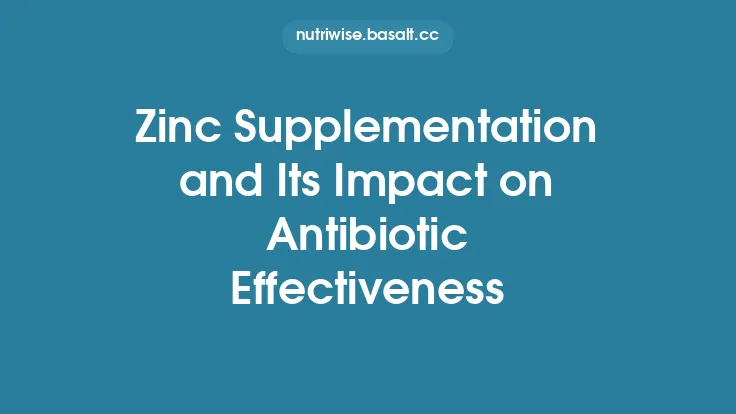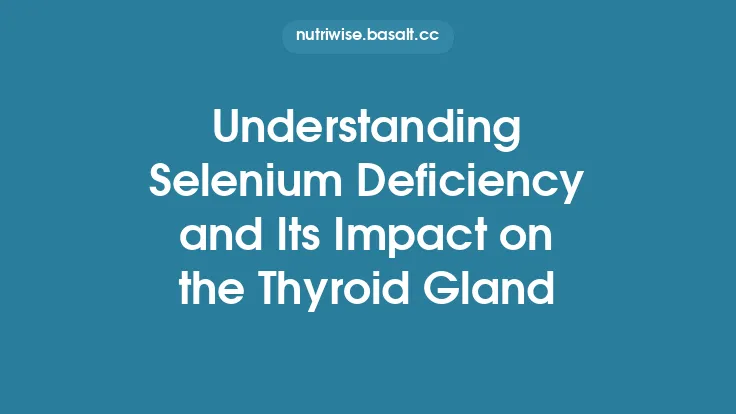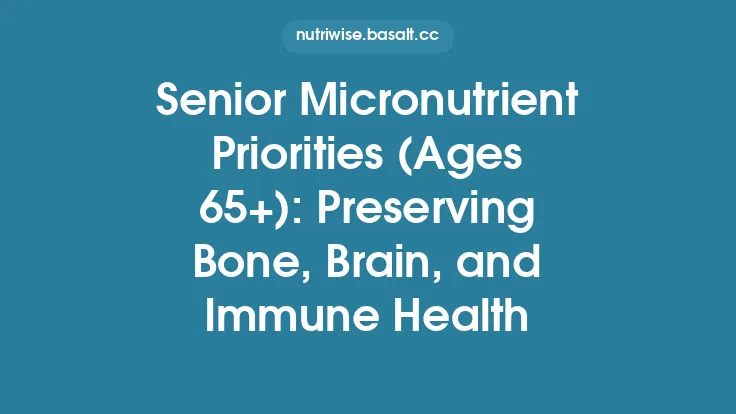Zinc is an essential trace element that participates in a multitude of biochemical pathways, from DNA synthesis to enzymatic catalysis. While its broad importance is well‑known, the consequences of insufficient zinc intake or impaired zinc metabolism are often under‑appreciated, especially when it comes to the body’s ability to fend off infections. When zinc stores dwindle, the immune system’s architecture begins to crumble, leading to a cascade of functional deficits that can manifest in subtle ways before progressing to overt disease. Understanding the signs of zinc deficiency, the mechanisms by which it erodes immune competence, and the steps needed to identify and correct it is crucial for anyone seeking to maintain robust health throughout the lifespan.
Understanding Zinc Deficiency
Zinc deficiency can be classified as either absolute (a true shortage of zinc in the body) or functional (adequate total zinc but impaired utilization). Absolute deficiency typically arises from inadequate dietary intake, chronic malabsorption, or increased losses (e.g., through diarrhea, burns, or renal disease). Functional deficiency, on the other hand, may result from conditions that alter zinc transport proteins, such as mutations in the ZIP (Zrt/Irt‑like Protein) and ZnT (Zinc Transporter) families, or from the presence of dietary antagonists (phytates, excessive iron or copper supplementation) that hinder zinc absorption.
Key physiological processes that maintain zinc homeostasis include:
- Intestinal absorption – primarily in the duodenum and jejunum via ZIP4 transporters.
- Cellular uptake and storage – mediated by a network of ZIP and ZnT transporters that shuttle zinc into the cytosol, organelles, or extracellular space.
- Excretion – mainly through the gastrointestinal tract, with minor losses via urine and sweat.
Disruption at any of these checkpoints can precipitate a decline in plasma zinc concentrations, which is the most readily measurable indicator of deficiency, albeit one that can be influenced by acute-phase responses and diurnal variation.
How Deficiency Undermines Immune Competence
Even modest reductions in zinc status can impair the immune system on several fronts:
- Barrier Integrity – Zinc is vital for the maintenance of epithelial tight junctions in the skin, respiratory tract, and gastrointestinal mucosa. Deficiency compromises these physical barriers, facilitating pathogen entry.
- Cell-Mediated Immunity – T‑lymphocyte development, particularly the maturation of naïve CD4⁺ cells into Th1 effectors, is zinc‑dependent. A shortage skews the Th1/Th2 balance toward a Th2‑dominant profile, weakening cell‑mediated responses that are essential for clearing intracellular pathogens.
- Cytokine Production – Zinc modulates the transcription of key cytokines (e.g., IL‑2, IFN‑γ). Deficiency leads to reduced cytokine output, blunting the signaling cascades that coordinate immune cell recruitment and activation.
- Phagocytic Function – Neutrophil chemotaxis, oxidative burst, and the ability to form neutrophil extracellular traps (NETs) are all attenuated when zinc is scarce, diminishing the first line of defense against bacterial invasion.
- Apoptosis Regulation – Zinc acts as a stabilizer of cellular membranes and a regulator of caspase activity. In its absence, inappropriate apoptosis of immune cells can occur, further depleting the pool of functional defenders.
Collectively, these deficits translate into a heightened susceptibility to infections, prolonged disease courses, and an increased risk of complications.
Clinical Signs and Symptoms to Watch
Zinc deficiency does not present with a single pathognomonic sign; rather, it manifests as a constellation of clinical clues that may be overlooked or misattributed. The following are the most reliable indicators, organized by system:
Dermatologic Manifestations
- Acrodermatitis enteropathica‑like lesions: Erythematous, scaly patches around orifices (mouth, anus) and on acral surfaces.
- Alopecia: Diffuse thinning or patchy hair loss, often accompanied by brittle nails.
- Delayed wound healing: Prolonged granulation tissue formation and susceptibility to secondary infection.
Gastrointestinal Symptoms
- Anorexia and dysgeusia: Reduced appetite and altered taste perception, sometimes described as a metallic or bitter taste.
- Diarrhea: Chronic, non‑bloody diarrhea that may exacerbate zinc loss.
Immunologic Indicators
- Recurrent infections: Frequent upper respiratory tract infections, otitis media, or pneumonia, especially in children.
- Prolonged febrile episodes: Fever that persists despite appropriate antimicrobial therapy.
- Poor vaccine response: Suboptimal seroconversion after routine immunizations.
Neurologic and Behavioral Signs
- Cognitive impairment: Difficulty concentrating, memory lapses, or slowed psychomotor speed.
- Mood disturbances: Irritability, depression, or anxiety, which may improve with zinc repletion.
Growth and Development Concerns (Pediatric Focus)
- Stunted growth: Height and weight below age‑appropriate percentiles.
- Delayed sexual maturation: Late onset of puberty markers.
It is important to note that many of these signs are nonspecific and can overlap with other micronutrient deficiencies (e.g., iron, vitamin A). A comprehensive clinical assessment is therefore essential.
Populations at Higher Risk
Certain groups are predisposed to zinc deficiency due to physiological, dietary, or environmental factors:
| Risk Group | Contributing Factors |
|---|---|
| Infants and young children | Rapid growth demands, exclusive breastfeeding without maternal zinc adequacy, weaning onto low‑zinc complementary foods |
| Pregnant and lactating women | Increased maternal zinc transfer to the fetus and infant, heightened metabolic turnover |
| Elderly individuals | Decreased dietary intake, reduced gastric acid secretion affecting absorption, polypharmacy with zinc‑binding drugs |
| Individuals with malabsorptive disorders (e.g., celiac disease, Crohn’s disease, short bowel syndrome) | Impaired intestinal uptake and chronic diarrhea |
| Patients with chronic liver or kidney disease | Altered zinc transport and increased urinary losses |
| Vegetarians and vegans | Higher intake of phytate‑rich grains and legumes that chelate zinc |
| Alcoholics | Poor nutrition, hepatic dysfunction, and increased urinary zinc excretion |
| Critically ill or severely burned patients | Massive zinc losses through wound exudate and heightened metabolic demand |
Targeted screening in these populations can facilitate early detection and intervention.
Diagnostic Approaches
Because plasma zinc concentrations fluctuate with acute-phase responses, a single measurement may be misleading. A robust diagnostic work‑up typically includes:
- Serum/plasma zinc assay – Preferred method; values <70 µg/dL (10.7 µmol/L) in fasting samples suggest deficiency, but interpretation must consider infection or inflammation status.
- Hair zinc analysis – Reflects longer‑term status but is susceptible to external contamination.
- Metallothionein levels – Emerging biomarker; low intracellular metallothionein may indicate functional deficiency.
- Complete blood count (CBC) and differential – May reveal lymphopenia or neutropenia consistent with impaired immunity.
- Immunologic functional tests – Assessment of delayed‑type hypersensitivity (e.g., skin test reactivity) or cytokine production assays can provide indirect evidence of zinc‑related immune dysfunction.
- Dietary assessment – Detailed food frequency questionnaires or 24‑hour recalls to estimate zinc intake relative to age‑specific recommendations.
When possible, clinicians should repeat zinc measurements after a period of convalescence to differentiate true deficiency from transient hypozincemia due to acute illness.
Management and Repletion Strategies
Correcting zinc deficiency involves both restoring adequate stores and addressing underlying causes. The therapeutic plan should be individualized based on severity, patient age, and comorbidities.
Acute Repletion
- Oral zinc salts (e.g., zinc gluconate, zinc sulfate) are the first line for most patients. Typical therapeutic doses range from 30–50 mg elemental zinc per day for 2–3 weeks, followed by a maintenance dose. (Exact dosing is beyond the scope of this article but should be guided by clinical judgment and monitoring.)
- Intravenous zinc may be warranted in cases of severe malabsorption, critical illness, or when oral administration is not feasible.
Addressing Contributing Factors
- Treat underlying malabsorption (e.g., gluten‑free diet for celiac disease, anti‑inflammatory therapy for Crohn’s disease).
- Reduce phytate intake or employ food preparation methods that degrade phytates (e.g., soaking, fermenting) to improve zinc bioavailability.
- Review medication regimens for agents that interfere with zinc absorption (e.g., high‑dose iron supplements, certain diuretics) and adjust as needed.
Monitoring and Follow‑Up
- Re‑measure serum zinc after 4–6 weeks of therapy to confirm repletion.
- Evaluate clinical response: resolution of dermatologic lesions, improvement in wound healing, and reduction in infection frequency.
- Continue maintenance supplementation or dietary adjustments to prevent relapse, especially in high‑risk groups.
Prevention: Maintaining Adequate Zinc Status
While the focus here is on deficiency, a proactive approach to zinc nutrition can safeguard immune competence:
- Balanced diet: Incorporate a variety of zinc‑containing foods (e.g., lean meats, legumes, nuts, seeds) while being mindful of inhibitors like phytates.
- Regular health checks: Periodic screening for at‑risk individuals can catch early declines in zinc status before clinical symptoms emerge.
- Lifestyle considerations: Limit excessive alcohol consumption, manage chronic stress, and ensure adequate sleep—all factors that influence micronutrient metabolism.
- Education: Inform patients and caregivers about the subtle signs of zinc deficiency, encouraging prompt medical evaluation when they arise.
By integrating these preventive measures into routine health maintenance, individuals can sustain a resilient immune system capable of confronting everyday microbial challenges.
Bottom Line
Zinc deficiency is a silent yet potent disruptor of immune competence. Its impact spans from compromised barrier defenses to weakened cellular immunity, manifesting in a spectrum of clinical signs that often go unnoticed until infections become recurrent or severe. Recognizing the at‑risk populations, employing a nuanced diagnostic strategy, and implementing targeted repletion and preventive tactics are essential steps for clinicians, nutritionists, and health‑conscious individuals alike. Maintaining optimal zinc status not only fortifies the immune system but also supports overall growth, wound healing, and neurological health—underscoring zinc’s indispensable role in human physiology.





